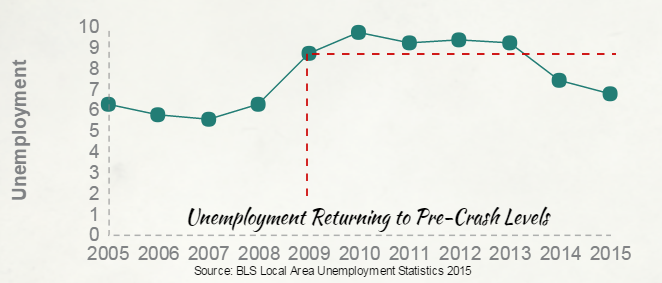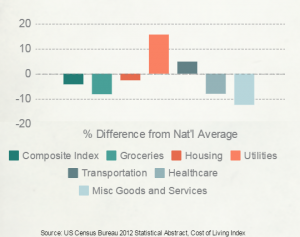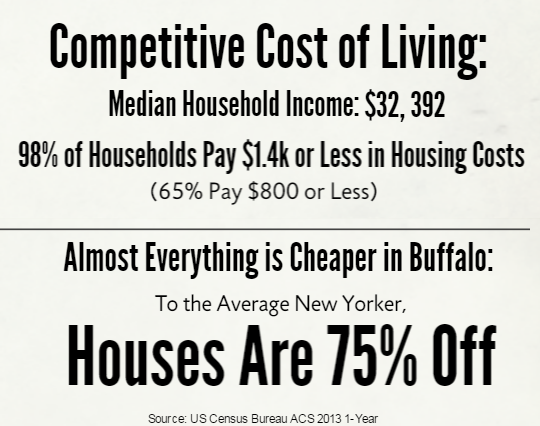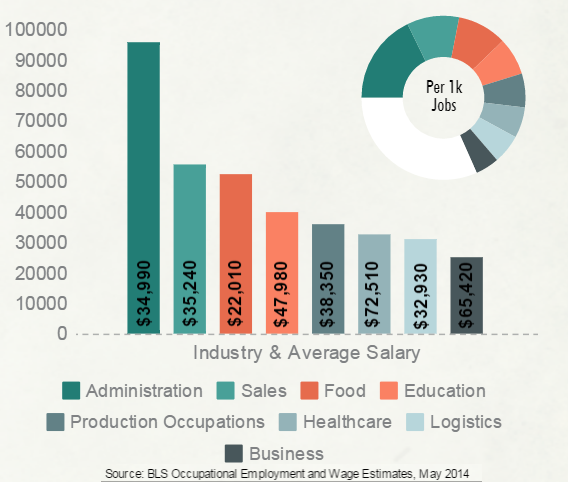
WNY Jobs Report
Living in WNY, you learn to respect seasons and cycles. The jobs numbers tell us Spring is finally here.
WNY Jobs Are Coming Back
The 2008 Financial Crisis hit WNY hard, though much of the late 20th century was no picnic. Buffalo fell from industrial prominence (the “City of Light”) to become one of our poorest Rust Belt cities, with a 31.4% poverty rate. When the national economy contracted, many thought the financial collapse would prove the final nail in WNY’s coffin; the jobs simply wouldn’t come back, this time.
Spoiler alert: they were wrong.

Unemployment is back to pre-financial crisis levels in the region, which is fantastic news. Further, year-on-year job growth of 2.3% means Western New York is matching the rest of the country in recovery — comparable to NYC and nearly twice that of the Albany metro area.
Comparing August of 2014 to August of 2015:
| Employment Sector | Jobs Added |
|---|---|
| Mining and Construction | 3,200 |
| Education and Health | 2,400 |
| Leisure and Hospitality | 1,600 |
| Financial Activities | 1,300 |
| Professional Services | 1,200 |
| Manufacturing | 500 |
| Trade, Transport, Utilities | 300 |
| Other Services | 200 |
Every month of the last three years brought year-on-year growth of WNY jobs. New employment engines – such as Solar City – and recovery programs are constantly in the news. Even a fraction of their projected effect could put the region on track to exceed national economic growth by a respectable fraction.
Long-term DOL projections predict double-digit growth in several sectors. It’s still early Spring, certainly, but the Western New York job market is coming out of its long winter.
Why Buffalo? Why Now?
There are three main factors at play in the regrowth of WNY, and of jobs in Buffalo specifically: local teamwork, smart government investment, and long-term regional trends.
Local Smarts … and a Billion Dollars
Jenna Kavanaugh, of Buffalo Niagara enterprise, makes a strong case for local teamwork driving Buffalo’s success. In a recent Huffington Post article, she calls out several cooperative efforts, such as:
- Conscious development of an entrepreneurial ecosystem
- Active collaboration between 22 regional colleges and universities
- Massive new manufacturing employment engines
- Local workforce training & development programs
The Buffalo Billion fuels many of these local efforts. Between 2011 and 2014, targeted investment and development programs brought 7,500 new WNY jobs and a $1.9 billion-with-a-B increase in wages. The Buffalo Manufacturing Works program Jenna cites is one example, as is Advance Buffalo; the latter is projected to support 17,000 new advanced manufacturing jobs in the region.

The Buffalo Billion targets manufacturing, healthcare, and tourism for significant investment, all sectors where Buffalo has quantifiable advantages just waiting for development. (Those 22 colleges and universities, for example, can fuel an explosion of health and life sciences development with intelligent funding.)
This program is one of the smartest economic growth programs I’ve seen in my lifetime and really deserves a thorough treatment of its own. For now, check out the executive summary and watch this space.
Competitive Cost of Living
And by competitive, I mean ‘cheap’. New York State is the third most expensive state to live in, but that’s hardly true everywhere.
Imagine you’ve got a city with a vibrant cultural scene, great food, a lot of smart people around, and everything is always on sale.

Consider housing prices. According to the Census Bureau‘s 2014 ACS, houses in Buffalo are basically 75% off by median value, compared to the state average. When buying a home elsewhere in the state becomes increasingly out-of-reach for most New Yorkers, a real city — with nightlife and everything! — where you can actually afford to settle sounds like a really good deal.
New Yorkers are voting with their feet, driving a 10.5% increase in population in Erie county. And companies are voting with their dollars, as the long term trends in Buffalo create perfect conditions for a kind of domestic offshoring.

When you have a skilled population, living in a developed city, with a lower ceiling for competitive wages than elsewhere in the state? That’s already an attractive workforce.
Add the state’s willingness to invest in training, local cooperative efforts to make you welcome, and that all this is sitting around in one of the wealthiest parts of the nation, just waiting for development?
It’s like offshoring, but with bagels and proper coffee.
In Demand Jobs in Buffalo
Department of Labor analysts regularly compile demand forecasts for economic regions in New York, combining historical analysis with an understanding of seasonal hiring activity. If you’re qualified in any of these fields, you can find a job almost immediately:
This doesn’t necessarily map to the most common jobs or best-paying, as you can see. The Bureau of Labor Statistics OES for May 2014 breaks down Buffalo jobs like so:

Administrative and sales occupations top the charts, for now, while healthcare and finance/business management jobs offer the highest average compensation.
In-demand forecasts are most useful for job seekers who need work immediately, rather than those seeking career positioning guidance. Getting into these higher-paid occupations takes planning and patience; pick your targets, set a job alert, and start laying the groundwork for your move.

Credit: Onasill ~ Bill Badzo, CC BY NC SA
Let’s Work Together
If you’re still reading, you care about helping New Yorkers find work and bringing prosperity to your region of the state. Why not work with us, creating community resources for job seekers in your area?
Future jobs reports will draw on reader suggestions — “What about nursing jobs in Buffalo?” — and input from local professionals. If you have questions or contributions, here’s how to get your name on the next report:
- Email us and start a conversation.
- Tweet us @NewYorkJobscom
- Find us on Facebook
- or leave a comment on this post.
If you’ve two minutes and insight to share, you can help New Yorkers find rewarding careers.
Featured Image Credit: Onasill ~ Bill Badzo, CC BY NC SA












